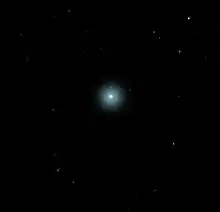 White dwarf (artist impression) | |
| Constellation | Sagittarius |
|---|---|
| Galaxy | Milky Way |
| Coordinates |
|
| Distance | 1,400 light-years |
| Characteristics | |
| Spectral type | White dwarf |
| Planets | WD 0032−317 b |
WD 0032−317 is a low mass white dwarf star orbited by brown dwarf WD 0032-317 b.
WD 0032−317
The white dwarf WD 0032−317 is located about 14,000 light years from Earth.[1] It is notable for its extreme temperature. WD 0032−317 has 40% of the Sun's mass, but has a much higher temperature of 37,000 Kelvin, compared to the suns temperature of 5778 Kelvin. WD 0032−317 formed about three billion years ago when a low mass star (possibly of 1.3 solar masses) expanded into its red giant phase. The star then blew out its outer layers leaving behind the helium-rich core (which is WD 0032−317).
WD 0032−317 b
The orbiting brown dwarf, WD 0032−317 b, was massive enough to survive the red giant's nova event.[2] It is an extremely hot and very large (75-88 Jupiter masses) brown dwarf that orbits WD 0032−317. One orbit from WD 0032−317 b takes only 2.5 hours. This object is tidally locked to its star with a day side temperature of 8,000 Kelvin and a night temperature of about 2000 Kelvin making its temperature equivalent to a planet orbiting close to a late stage B-type star. The intense ultraviolet (UV) exposure can break down the molecules in WD 0032−317's atmosphere and vaporize materials from the surface of the brown dwarf.[3][4][5]
References
- ↑ Atkinson, Nancy (2023-08-17). "This Brown Dwarf is 2,000 Degrees Hotter Than the Sun". Universe Today. Retrieved 2023-08-28.
- ↑ Yirka, Bob; Phys.org. "Discovery of a Brown Dwarf Hotter Than the Sun". phys.org. Retrieved 2023-08-28.
- ↑ Hallakoun, Na’ama; Maoz, Dan; Istrate, Alina G.; Badenes, Carles; Breedt, Elmé; Gänsicke, Boris T.; Jha, Saurabh W.; Leibundgut, Bruno; Mannucci, Filippo; Marsh, Thomas R.; Nelemans, Gijs; Patat, Ferdinando; Rebassa-Mansergas, Alberto (2023-08-14). "An Irradiated-Jupiter Analogue Hotter Than the Sun". Nature Astronomy: 1–12. arXiv:2306.08672. doi:10.1038/s41550-023-02048-z. ISSN 2397-3366.
- ↑ Gamillo, Elizabeth (15 August 2023). "Astronomers Find a Brown Dwarf That's Hotter Than the Sun | Astronomy.com". Astronomy Magazine. Retrieved 28 August 2023.
- ↑ "A Brown Dwarf Star Serves as an Ultrahot-Jupiter Analogue". pubs.aip.org. Retrieved 28 August 2023.